How are cucumbers grown? Cucumbers, a staple in salads and sandwiches, have a growth process that is as fascinating as the refreshing taste they bring to our tables. This guide will walk you through the essential steps and tips to grow cucumbers successfully. We’re going to take a deep dive into the world of cucumber cultivation, offering you a glimpse into the secrets behind growing these green delights.
Cucumbers are grown by selecting a suitable variety and planting seeds in well-prepared soil rich in organic matter. The seeds can be started indoors in regions with a short growing season and transplanted outdoors when the weather warms up. Throughout the growing season, the plants require consistent watering, and the use of a trellis is recommended for certain varieties to encourage vertical growth. As they mature, cucumbers should be harvested promptly to encourage continuous production.
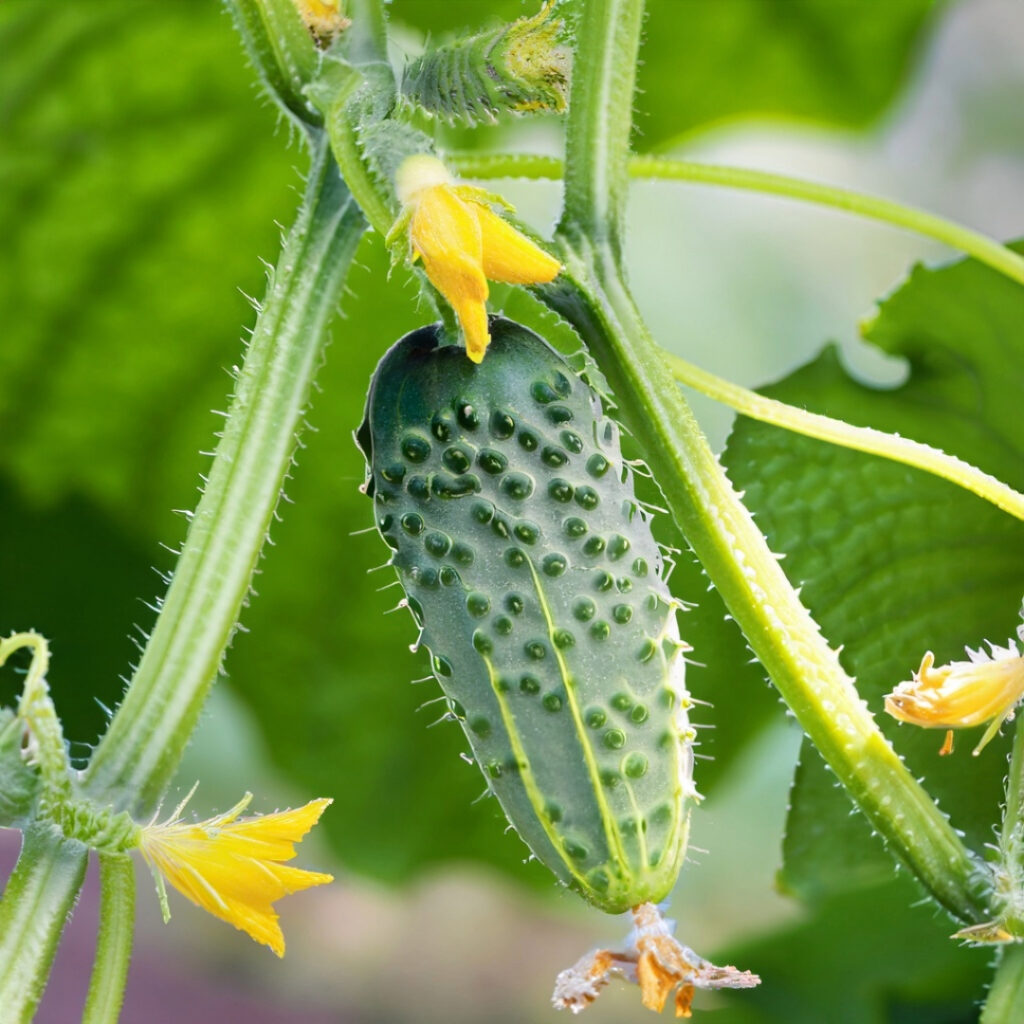
Introduction to Cucumber Growing
Growing your own cucumbers can be a rewarding and fruitful endeavor. Before we dive into the specifics of how to grow them, let’s take a moment to understand what cucumbers are.
What are Cucumbers?
Cucumbers belong to the gourd family, which includes pumpkins, melons, and squashes. These green, elongated fruits are known for their crisp texture and refreshing taste. The cucumber plant is a vine that grows rapidly, often requiring support structures like trellises to grow optimally. Here are a few interesting facts about cucumbers:
- They are composed of about 95% water, making them a hydrating snack especially during summer.
- Cucumbers have been cultivated for over 3,000 years.
- They originated in South Asia but are now grown worldwide.
- There are various types of cucumbers, including slicing, pickling, and burpless varieties.
Getting Started with Growing Cucumbers
Growing cucumbers from seed can be an exciting venture. From choosing the right variety to planting the seeds, each step is crucial in ensuring a successful harvest. In this section, we will guide you through the initial steps to set up your cucumber garden.

Choosing the Right Variety of Cucumber
Before you embark on your cucumber growing journey, selecting the right variety is a crucial step. Different cucumber varieties have distinct characteristics that cater to various preferences and gardening conditions. Here are some factors to consider when choosing the type of cucumber to grow:
- Purpose: Determine whether you are growing cucumbers for salads or pickling, as different varieties excel in different uses.
- Climate: Choose varieties that thrive in your local climate to ensure a successful harvest.
- Space: Evaluate the space in your garden. Some varieties are better suited for vertical growth, while others sprawl horizontally.
- Disease Resistance: Opt for varieties known for their resistance to common cucumber diseases to minimize potential issues.
“Selecting the right variety is a significant step towards a successful harvest. Seek advice from your local nursery or refer to the seed packet for recommended cucumber varieties.”
Common Cucumber Varieties
To assist you in making an informed choice, here is an overview of some popular cucumber varieties:
- English Cucumbers: These are long, slender, and have a sweet taste, encased in a smooth, dark green skin. They are great for salads due to their firm flesh.
- Persian Cucumbers: A smaller variety, known for their thin skin and mild flavor, making them a crunchy addition to fresh salads.
- Kirby Cucumbers: Predominantly found in North America, these cucumbers have a smooth skin and a vibrant green color, suitable for both salads and pickling.
- Lemon Cucumbers: Recognizable by their yellow, round appearance, they offer a mild and sweet flavor, adding a unique touch to your dishes.
- Armenian Cucumbers: These are long and slender with a mild flavor, appreciated for their thin skin and minimal seeds, making them a refreshing snack.
- Japanese Cucumbers: These cucumbers are slender with a deep green skin, offering a mild flavor with a hint of melon, adding a unique taste to your salads.
- Beit Alpha Cucumbers: A smaller variety, known for their crunch and slightly sweet flavor, perfect for a crunchy snack or salad addition.
- Slicing Cucumbers: These can grow quite large and are best enjoyed fresh, adding a crisp texture to sandwiches or salads.
- Pickling Cucumbers: Smaller in size, these are the go-to variety for making pickles, offering a crisp texture that holds well in brines.
- Burpless Varieties: These are known for their thin skin and lack of cucurbitacin, which eliminates the bitter flavor often found in other varieties.
By considering these aspects and choosing a variety that suits your preferences and garden conditions, you set the stage for a fruitful and enjoyable cucumber growing experience.
Growing Cucumbers in Containers
Not everyone has the luxury of a spacious garden, but that shouldn’t deter you from enjoying homegrown cucumbers. Growing cucumbers in containers is a feasible and rewarding venture. Here are some tips to get you started:
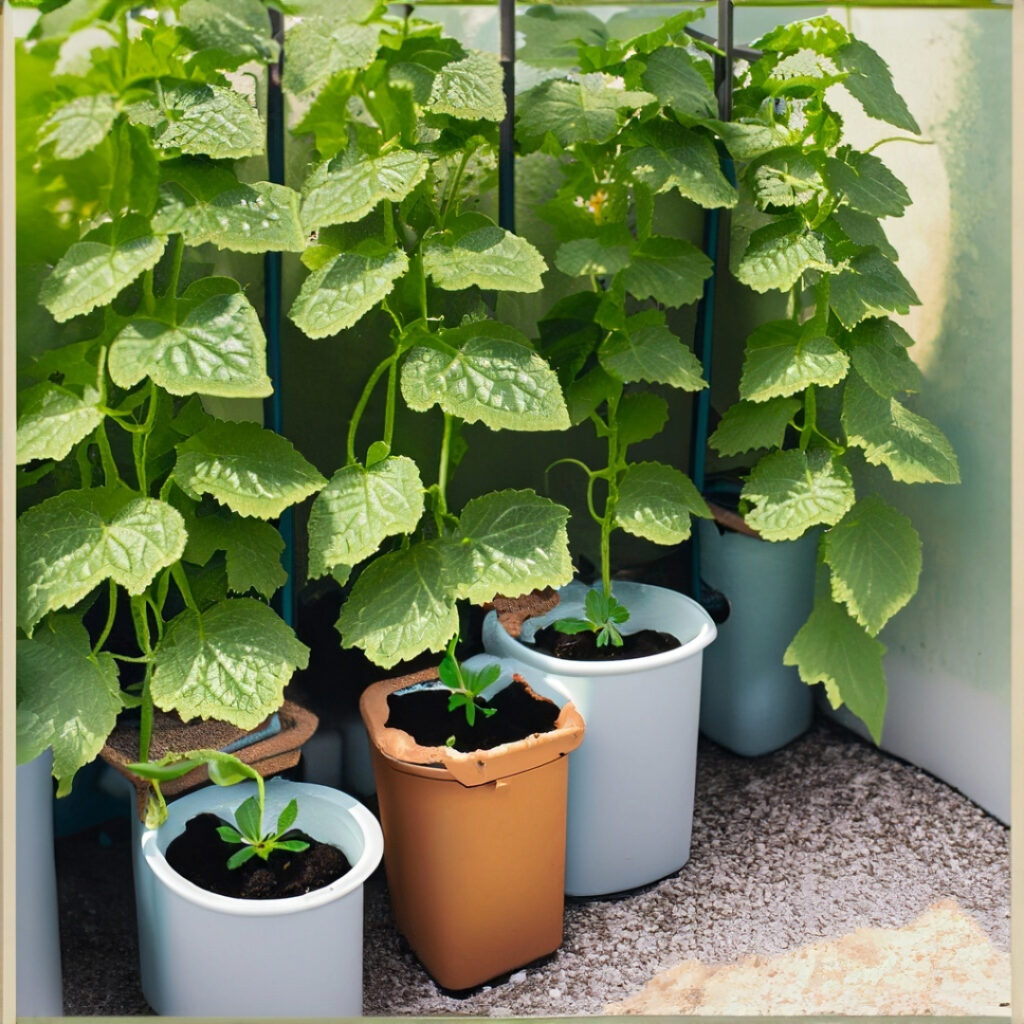
- Choosing the Right Container: Opt for containers that are at least 12 inches deep and 24 inches wide to provide ample space for the roots to grow.
- Soil Preparation: Use high-quality potting soil that ensures good drainage and retains moisture well.
- Sunlight: Ensure the containers are placed in a location that receives at least 6-8 hours of sunlight daily.
- Watering: Container plants require more frequent watering. Make sure to keep the soil consistently moist but not waterlogged.
- Fertilizing: Since nutrients can be washed out of the soil more quickly in containers, regular fertilization is necessary to supply the plants with the necessary nutrients.
- Varieties: Consider growing bush varieties or smaller cucumber varieties that are well-suited for container gardening.
- Support: Even in containers, cucumbers will benefit from some support. Consider installing a small trellis or stake to support the growing vines.
- Pest Control: Keep an eye out for pests and diseases, and manage them promptly to prevent any damage to your plants.
By considering container gardening, you can enjoy fresh, crunchy cucumbers even with limited space. It’s a great way to delve into the world of gardening without the need for a large garden plot.
Preparing the Soil
Preparing the soil is a vital step in the process. The soil around the plants needs to be rich in organic matter and well-draining to promote healthy growth. Here are some tips to prepare the soil:
- Test the Soil: Before planting, test the soil to determine its pH and nutrient levels.
- Organic Matter: Incorporate organic matter like compost or well-rotted manure to enrich the soil.
- Drainage: Ensure the soil has good drainage to prevent waterlogging.
- Weed Control: Remove weeds from the planting area to reduce competition for nutrients.
Planting the Seeds
Once the soil is prepared, it’s time to plant the seeds. Here’s a step-by-step guide to help you get started:
- Choosing Seeds: Purchase high-quality cucumber seeds from a reliable source.
- Understanding the Growing Season: The growing season for cucumbers varies depending on the geographical location. In general, cucumbers thrive in warm weather and should be planted when there is no risk of frost, and temperatures have consistently reached above 60°F (15°C). It’s essential to be aware of the growing season in your area to time your planting appropriately.
- Indoor Sowing: If you live in a region with a short growing season, you might consider starting the cucumber seeds indoors about 3 weeks before the last expected frost.
- Outdoor Sowing: In warmer climates, you can directly sow cucumber seeds in the garden once the danger of frost has passed.
- Planting Depth: Plant cucumber seeds at a depth of about 1 inch, and space them about 36 to 60 inches apart, depending on the variety.
- Watering: After planting, water the seeds thoroughly to encourage germination.
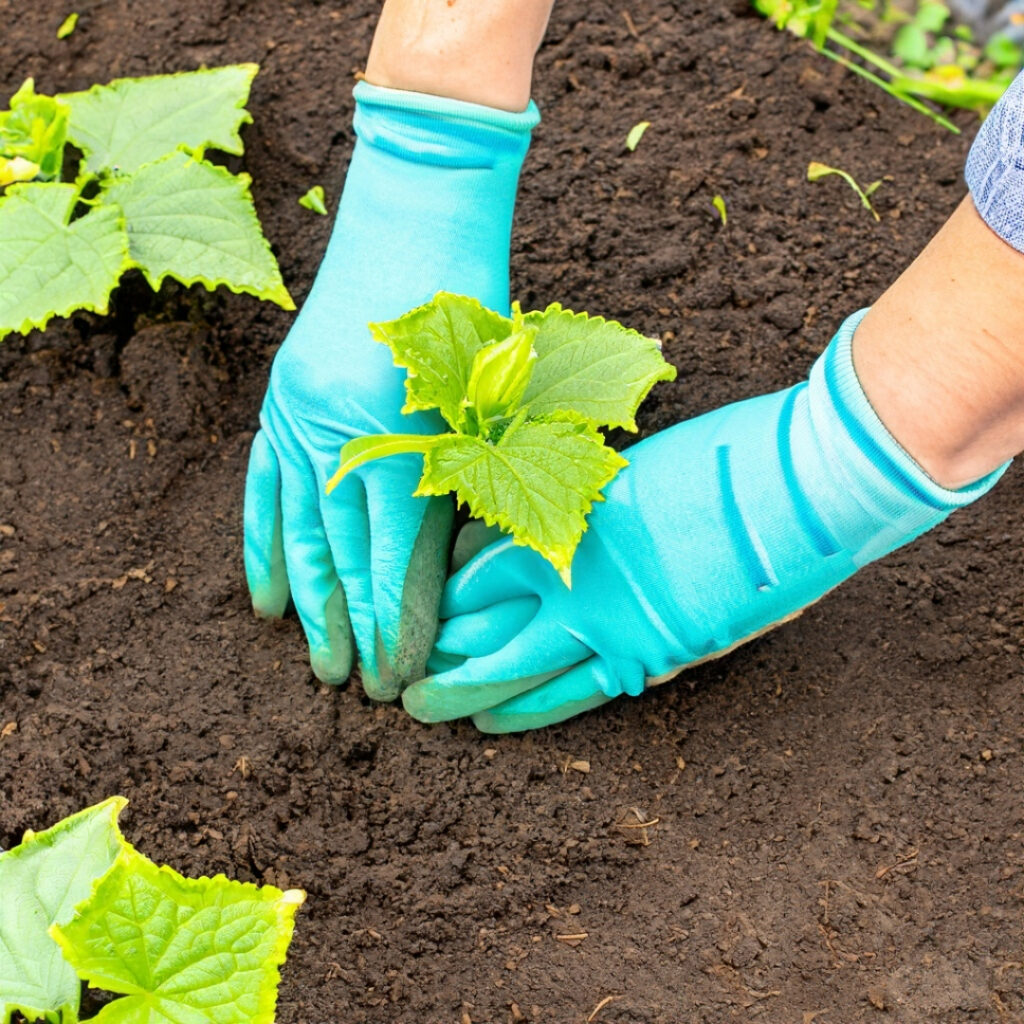
Section 3: Caring for Your Cucumber Plants
Getting your cucumber plants to thrive goes beyond just putting the seeds in the ground. You have to take care of them throughout their growing season to make sure you get the most out of your plants. In this part, we’ll talk about the important stuff like watering, putting up a trellis, and keeping those pesky pests away from your plants.
Watering and Nutrition
Proper watering and nutrition are vital for the healthy growth of cucumber plants. Here are some guidelines to help you nurture your plants effectively:
- Frequency of Watering: It’s essential to water your cucumbers regularly, especially during dry spells. The soil should always be moist but not waterlogged.
- Time of Watering: Early morning is the best time to water the plants, as it allows the leaves to dry out during the day, preventing fungal diseases.
- Nutrition: Cucumbers are heavy feeders. Enrich the soil with organic matter and use a balanced fertilizer to provide the necessary nutrients.
- Mulching: Mulch around the plants to retain moisture and prevent weeds.
“Remember, the key to a successful crop is to plant in full sun and provide ample water and nutrients.”
Trellising Your Cucumbers
Trellising is a technique that involves supporting the plants as they grow. Here’s how you can set up a trellis for your cucumbers:
- Choosing a Trellis: Select a sturdy trellis that can support the weight of the growing plants.
- Installation: Install the trellis early in the season to avoid disturbing the roots later on.
- Training the Vines: As the plants grow, guide them to grow cucumbers vertically. This not only saves space but also promotes better air circulation.
- Maintenance: Ensure that the plants are evenly distributed and trained up a trellis to grow healthily.
“A well-maintained trellis can help your cucumbers grown on a trellis to yield more fruit and reduce the risk of diseases.”
Protecting Your Plants
Protecting your plants from pests and diseases is a crucial aspect of cucumber cultivation. Here are some tips to protect young plants:
- Pest Control: Watch out for pests like cucumber beetles and striped cucumber beetles. Use organic pesticides or encourage natural predators to control the pest population.
- Disease Management: Implement crop rotation and use disease-resistant varieties to prevent common cucumber diseases.
- Physical Barriers: Use row covers to protect the young plants from pests and extreme weather conditions.
- Regular Monitoring: Regularly inspect your plants for signs of pests and diseases, and take timely action to prevent any damage.
Section 4: Understanding the Growth Cycle of Cucumbers
Growing cucumbers is a journey that unfolds through various stages, from the emergence of the first seedling to the blossoming of flowers and the eventual fruiting. Understanding the growth cycle of cucumbers can provide you with insights to nurture your plants better and anticipate the needs at each stage. Let’s delve deeper into the growth stages and the flowering and pollination process of cucumbers.
The Growth Stages
The life cycle of a cucumber plant can be broadly categorized into several stages. Here’s a glimpse into the fascinating journey that every cucumber plant undergoes:
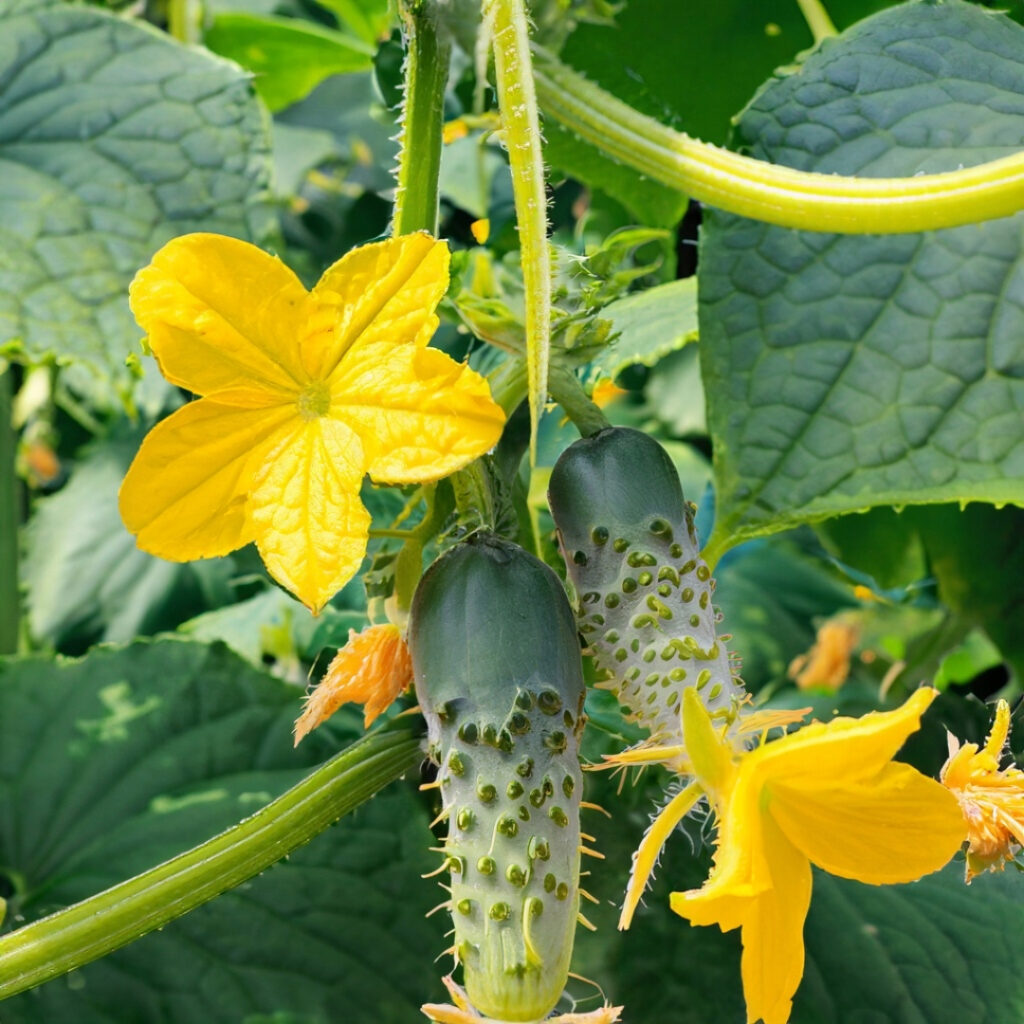
- Germination (Seedling Stage): The journey begins with the germination of the seedling. During this stage, the seeds sprout, and the young plants start to emerge from the soil.
- Vegetative Growth: As the plants reach a certain growth point, they transition into the vegetative stage, where they focus on developing leaves and stems. This is when you’ll notice the plants starting to grow quickly.
- Vining: Eventually, the plants start to vine, extending their reach and preparing for the flowering stage. It’s essential to provide support to prevent the vine too long and become unmanageable.
- Flowering and Fruit Setting: In this stage, the plants produce flowers, signaling the beginning of the fruit-setting phase.
“Each one plant undergoes a remarkable transformation, showcasing the wonders of nature at every stage.”
Flowering and Pollination
The flowering stage is a critical phase in the life cycle of a cucumber plant. Here’s what happens during this stage:
- Flower Development: Cucumber plants develop two types of flowers: male flowers and female flowers. Initially, you will notice the plant producing more male flowers, followed by the emergence of female flowers.
- Pollination: For fruit setting to occur, pollination is necessary. It involves the transfer of pollen from male to female flowers. You can pollinate the flowers manually or rely on natural pollinators like bees.
- Fruit Setting: Once pollination is successful, the female flowers develop into fruits. It’s fascinating to observe cucumbers that produce male and female flowers, working in harmony.
“Understanding the flowering and pollination process is key to nurturing a successful cucumber garden.”
By gaining a deeper understanding of the growth cycle of cucumbers, you can anticipate the needs of your plants at each stage and ensure success. In the next section, we will explore the exciting phase of picking your cucumbers and enjoying the fruits of your labor.
When and How to Harvest Cucumbers
The moment of harvest is a rewarding time in the life cycle of your cucumber garden. It’s when you get to reap the fruits of your labor and enjoy fresh, crisp cucumbers right from your garden. In this section, we will guide you on when and how to harvest cucumbers, ensuring that you pick them at the right time and in the right way for the best flavor and texture.
When to Harvest
Determining the right time to harvest cucumbers is crucial to enjoy the best flavor and texture. Here are some pointers to help you identify the right time for harvesting:
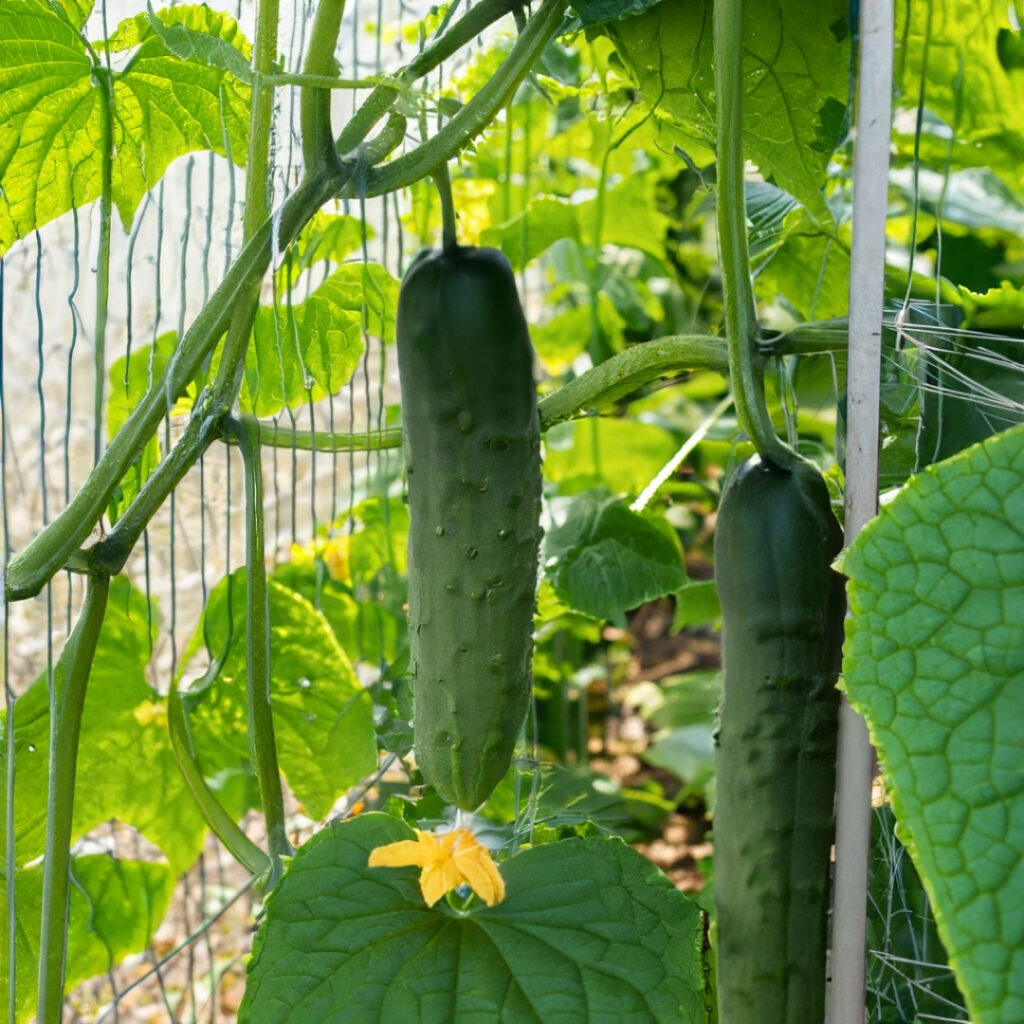
- Size and Appearance: Generally, cucumbers are ready to harvest when they are about 6 to 8 inches long. However, the ideal size can vary depending on the variety.
- Taste Test: Conduct a taste test to determine the right time for harvest. Generally, cucumbers taste best when they are young and crisp.
- Observation: Keep a close eye on your cucumber plants. As soon as the cucumbers get to the desired size and firmness, it’s time to harvest.
“Remember, cucumbers should be harvested before they become too large and seedy, as oversized cucumbers can be bitter.”
How to Harvest
Harvesting cucumbers is a straightforward process, but following the right technique can ensure that you pick cucumbers without damaging the plants. Here’s how to go about it:
- Use Sharp Scissors or Pruners: Utilize sharp scissors or pruners to cut the stem above the fruit, leaving a small portion of the stem attached to the cucumber.
- Handle with Care: Handle the cucumbers gently to avoid bruising or damaging the skin.
- Regular Harvesting: Regular harvesting encourages the plants to produce more fruit. Make sure to check your plants daily during the peak harvest season.
- Special Considerations for Pickling: If you are growing pickling cucumbers, note that pickling cucumbers should be harvested when they are smaller and firmer compared to slicing cucumbers.
“Harvesting at the right time ensures that your cucumbers are best enjoyed fresh and crisp, offering a delightful crunch with every bite.”
By following these guidelines, you can enjoy a successful harvest and savor the fresh, homegrown cucumbers from your garden. In the concluding section, we will share some delicious recipes and tips to enjoy your cucumber harvest to the fullest.
Tips and Tricks for a Bountiful Harvest
Growing cucumbers can be a rewarding experience, especially when you are equipped with the right knowledge and techniques. While cucumbers are relatively easy to grow, having some tips and tricks up your sleeve can ensure a bountiful and successful harvest. In this section, we will share some guidance on companion planting and how to avoid common issues that might arise during the growing process.
Companion Planting
With a little planning, you can grow plants together that will benefit each other. Here are some companion plants that can be beneficial when growing cucumbers:
- Marigolds: These vibrant flowers can help deter pests like nematodes and cucumber beetles.
- Nasturtiums: Known to repel a variety of pests, including aphids and whiteflies.
- Beans: These fix nitrogen in the soil, providing cucumbers with the necessary nutrients.
- Corn: Provides shade and support for cucumber vines, promoting vertical growth.
- Amaranth: See the video below for an interesting take on using Amaranth as a companion for cucumbers
“Companion planting is not just about pest control; it’s about creating a harmonious garden ecosystem where plants support each other.”
Avoiding Common Issues
Growing cucumbers is generally easy to grow from seed, but like any gardening venture, it comes with its set of challenges. Here are some tips to avoid common issues:
- Bitterness in Cucumbers: This can be caused by irregular watering and extreme temperatures. Ensure consistent watering and mulching to prevent bitterness in cucumbers.
- Pest and Disease Management: Implement preventive measures to avoid pests and diseases that can ruin the plant.
- Proper Spacing: Ensure that the plants are not overcrowded to promote better air circulation and prevent disease spread.
- Nutrient Management: Provide balanced nutrition to avoid nutrient deficiencies and promote healthy growth.
“Following a comprehensive guide to growing cucumbers can be the best way to grow cucumbers, ensuring a healthy and bountiful harvest.”
By adhering to these tips and tricks, you can look forward to a successful growing season. In the final section of our guide, we will share some delightful recipes to help you enjoy your fresh cucumber harvest in various delicious ways.
Conclusion
Growing cucumbers is more than just a gardening activity; it’s an opportunity to connect with nature and enjoy the fruits of your labor. As we wrap up this comprehensive guide, we hope that you are equipped with the knowledge and enthusiasm to cultivate cucumbers in your garden and enjoy a bountiful harvest of fresh cucumbers.
Enjoying Your Homegrown Cucumbers
After all the hard work and dedication, it’s time to savor the crisp and refreshing taste of your homegrown cucumbers.
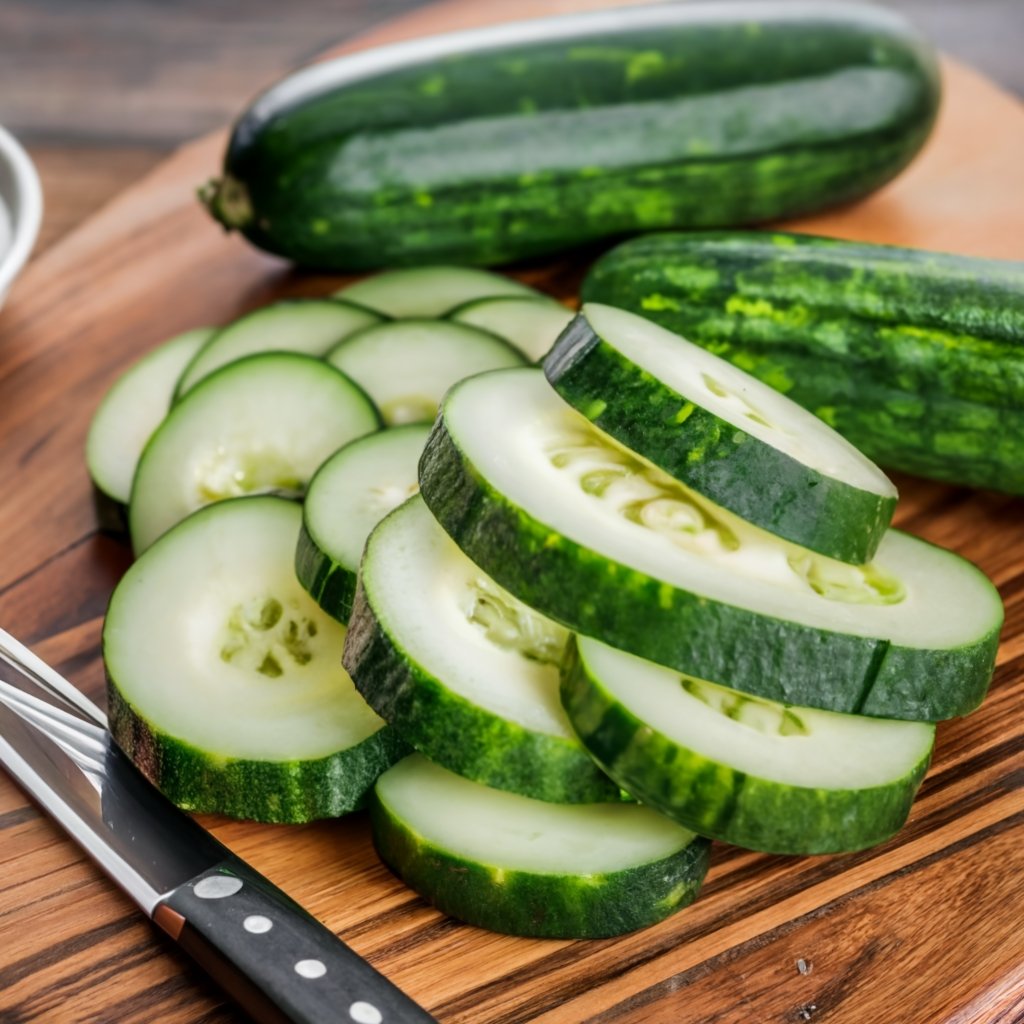
- Fresh Salads: Use your fresh cucumbers in salads, combining them with other vegetables and a drizzle of olive oil for a healthy and refreshing meal.
- Pickling: Transform your cucumbers into pickles to enjoy them for a longer period.
- Storage: To keep your cucumbers fresh for a longer time, store the whole cucumbers in a plastic bag in the vegetable crisper of your refrigerator. Remember, it’s best not to store cucumbers in the refrigerator for more than a week to enjoy their fresh taste.
- Sharing the Bounty: Share the fruits of your labor with friends and family, spreading the joy of homegrown produce.
“Growing and enjoying fresh cucumbers is a rewarding experience, offering a sense of accomplishment and the joy of savoring homegrown produce.”
As you embark on your cucumber growing journey, remember that the process is just as rewarding as the harvest. We wish you a successful and joyful gardening season, filled with the crisp and refreshing taste of cucumbers straight from your garden.
